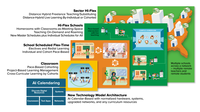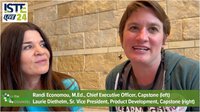The way communities interact with their schools has changed significantly, especially over the last few years, and understanding a community’s wants and expectations is critical to being able to meet their needs. This includes when it comes to services such as enrolling students, managing lotteries for choice programs, and managing and processing records.
In order to help school districts better understand their communities' needs and expectations for accessing these types of services, we partnered with the Center for Generational Kinetics to conduct a national survey on this topic. The survey focused on how people feel about tasks such as visiting school offices and mailing documents; their access to and use of printers, fax machines, computers, mobile devices and checkbooks; their trust in district operations, and more.
Here are some of our key findings – and insights/advice for school and district leaders. For the full report, visit https://go.scribsoft.com/communications-with-education-systems-study-guide.
1) More families use phones, not fax machines. Overall, our survey found that more people have access to digital technology (mobile phones, computers and internet) then to products that support paper-based interactions (printers, copy machines, fax machines and scanners). For instance, more than 75% of respondents said they have access to a mobile device and/or the internet, while fewer than 25% said they have access to a copy machine or fax machine. Older respondents were more likely to have access to all types of products and technologies than those in the younger age groups.
● Advice for districts: Make sure resources and communication channels are accessible online and are mobile-friendly. Consider the easiest way for families to both receive and provide information to their school (phone, emails, texts etc.) and make sure those options are available. Also, consider the age ranges of the people your district is serving so you can make sure your district is prepared for shifts in expectations and technology access as your community ages.
2) Low-income and/or non-English speaking families have less access. When we delved deeper into the issue of access, we found that people with lower household incomes ($34,000 or less a year) have less access to items such as envelopes, stamps, checkbooks, printers, scanners, copiers and fax machines than those with higher household incomes. Rather, those with lower incomes are much more reliant on mobile technology to communicate and do business. This brings up an important equity issue. When families don’t have access to paper-based products and technologies at their homes, they are more likely to end up paying for use at a store or institution (FedEx, CVS, public library, college, etc.). Something as simple as printing a form or making a copy of a document for an application or a record request can end up being costly, time-consuming and inconvenient. Our survey found this is also true for families who do not speak English.
● Advice for districts: If your district serves lower-income communities and/or communities with a large number of non-English speaking families, consider the cost associated with paper-based processes like records requests and student registration. Making processes like records requests or registration accessible online can make a huge difference in the amount of time and money needed from families. When transitioning to digital, consider platforms that have translation features. If you require a paper-based system, make those papers available for parents to pick up at other locations that they might already be traveling to in order to reduce transportation costs for families.
3) Having only paper-based processes makes schools look bad. The experience people have with their schools’ processes and transactions impact their perceptions. Our survey revealed 50% of survey respondents get frustrated or annoyed when educational institutions require them to adhere to paper-based processes such as printing materials, paying by check, or faxing documents, and 46% said they are not confident in their school administrative systems because those systems still use so many paper-based processes. Conversely, when asked how they would feel if educational institutions provided easier ways to complete transactions, the majority reported they would feel relief, or that such an option is what they would expect.
● Advice for districts: A whopping 76 percent of our survey respondents said they expect more efficient access, service and communication from school administrative systems then they currently get. Specifically, more than 70% of respondents said they would value having services such as online payment systems, online dashboard access, automated messaging (emails, voice messages and text) and mobile friendly access, and a record of their interactions. Making these options available will go a long way toward improving perceptions of your district and improving service for your community.
4) Mobile payments- yes. Checkbooks -no. We delved deeper into the paper-based systems and asked specifically about payment options. Our survey found that when it comes to making payments to school districts, people want more digital options. Mobile payments have become commonplace for everything from food delivery to utility bills. And, although some survey respondents still want in-person options for these transactions, overall, 65% would prefer to be able to make payments online through a district website or a mobile application. In fact, 44% of Gen Z respondents (ages 18-26) said they weren’t positive they could correctly write a check to someone.
● Advice for districts: Consider moving to a digital payment system. This will help streamline the payment process and improve convenience for families, and will also save staff members’ time. Having a digital solution has the added benefit of allowing the school staff to record the transaction and providing an audit trail.
5) Different types of communities have different expectations. Our survey found that the trends in expectations that we are seeing are not universal, they differ based on the type of community respondents lived in. We found that those who live in suburban locales are more likely to have access to all technologies at home (fax, printer, computer, etc.). Those in rural locales are more likely to feel surprised if education and government institutions allow digital transactions. And those in urban locales are more likely to consider paper-based transactions a thing of the past, and lack confidence in institutions that use them.
● Advice for districts: Explore the perspectives, preferences and tendencies of those in your specific communities to understand how people want to interact with your district. Survey families and alumni to get their feelings on what they want. Although in general digital access is becoming more popular, those in your district may have specific requests for how they want to handle transactions with their district. Taking time to consider the opinions of your specific stakeholders will help provide better, more tailored services.
The bottom line from our survey was that while paper-based processes may still have a place in some communities, most also want online options for communication, services and payments. Knowledge is power, and when district leaders understand their communities’ preferences, access issues, and expectations, they can make informed decisions about how to support them which is a win for both the community and the district.
About the author

Misty Reinhardt is the Director of Product Management for Scribbles Software. She has spent more than a decade in EdTech and loves working with customers to improve their work experience and make the lives of their staff and families easier.











